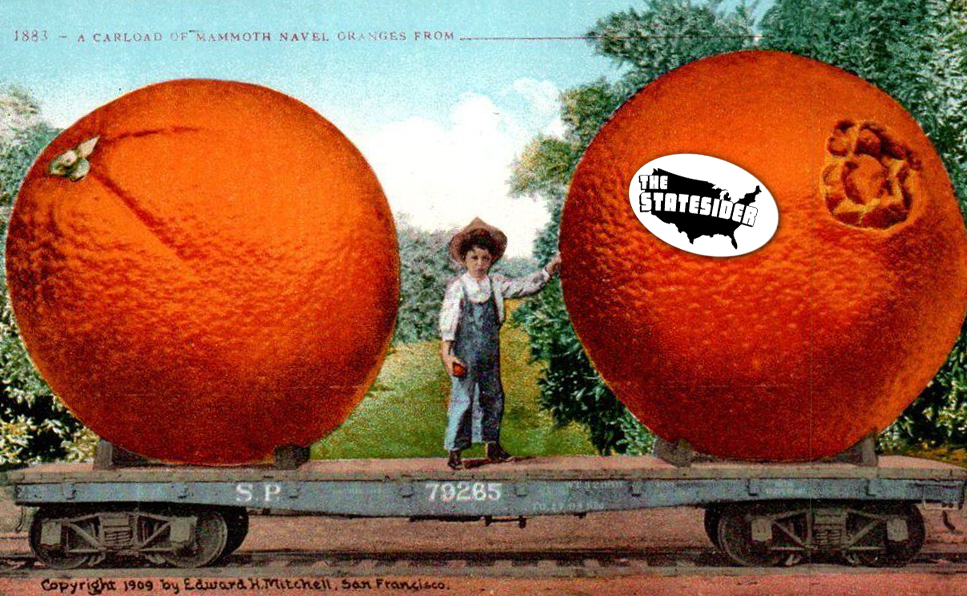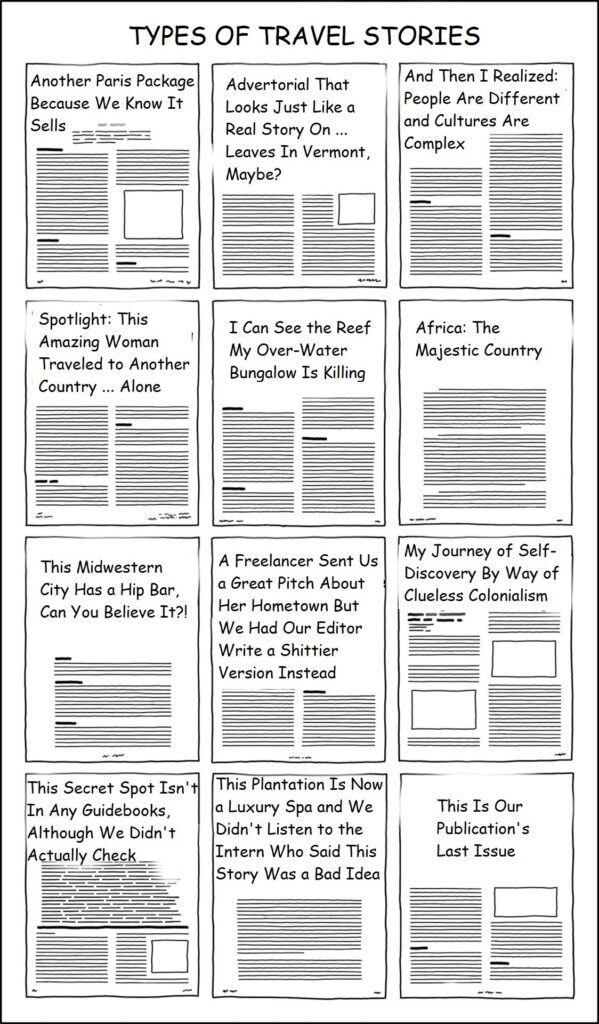🥧 In this Final Issue of the Statesider 🍰
Lessons learned, meals eaten, roads traveled. And our thanks.
In 2021, Randall Munroe at XKCD published a funny-because-it’s-painfully-true cartoon “Types of Scientific Paper.” Much internet riffing ensued, giving the XKCD comic new life as a social meme. In our Statesider Slack channel, we immediately started toying with a travel version.
Boy, was there a lot of material.
With our combined years of experience in and around the travel industry, we knew just where the tender spots were — we had become fairly cynical about the state of the industry as it exists in the 2020s. Clueless colonialism: check. Callous environmental damage: check. Whitewashed racism: so much check. Advertorials and feature articles completely indistinguishable from each other: check — and it never ends.
We ended on a particularly dark note for anyone who has worked in travel publishing — or media at all: “This Is Our Publication’s Last Issue.”
We were not unaware that we were also writing our own eventual obituary.
Which is to say: This is goodbye for The Statesider. After four years of operation, we’re turning the sign (and please picture a hand-carved wooden sign held by a chainsaw art bear) to “CLOSED.”
Our end, as a publication, is not the result of the typical reasons that travel publications wink out of existence. We didn’t go bankrupt (we never made money to begin with, which is a funny way of insulating yourself from worrying about bankruptcy). We did not get bought and killed by a multinational media conglomerate (but we’d be willing to try it once, what the hey). We didn’t fail in any standard way — or at all.
This was, from the beginning, a labor of love started when all three of us were in very different places in our lives, and now we’re somewhere else — somewhere with not enough time to devote to keeping The Statesider running.
Before we sign off, we wanted to share some things we learned along the way. The experience of launching the Statesider and running it through a global pandemic changed how we view digital media and the act of travel. Despite the cynical, snarky perspective in that graphic above, we do see reason for hope or something like it.
The narrative about our national character is inadequate.
One of the subjects we kept coming back to over the last few years was the incredible breadth of the USA’s many cultures and threads of history, even when considered through the lens of standard-issue Americana. Take cowboys, that classic archetype. Beyond all the John Wayne/Clint Eastwood/Marlboro Man tropes, there’s also a rich history of Black cowboys and Jewish cowboys and trans cowboys and LGBTQ rodeos and Native American rodeos and Mexican-American rodeos and women riding the range and playing essential roles in the Old West. It’s not just that so many myths about American identity and “exceptionalism” are bullshit — it’s just as important to understand what stories have been left out of the collective narrative.
It takes the most trivial of effort to find stories about our history written by people who are not straight white men, and the history of the people who were here before any Europeans arrived, and it is such a worthwhile pursuit. Plus, taking a more expansive view of the American experience, past and present, leads to so many interesting chapters. Like, there’s a prevailing colonialist narrative around the establishment of the US as a country, but there was a hotel operating in Santa Fe before the pilgrims landed at Plymouth Rock! That’s fascinating!
Put another way: Read the plaque, but also question the plaque.
See: Tracing a Trail of Black Rebellion by Jalen Coats
We undervalue the options in our own country.
We also don’t think enough about the USA as a travel destination with endless intrigue. It’s easy to aggrandize the museums of Paris or the temples of Southeast Asia, but all too many Americans act as though we can’t find great cultural or historic iconography right here in the US.
The national parks and state parks (and local parks, for that matter) offer more than enough wonders to fill a lifetime, and even as a relatively new nation, we have a richness of architecture, art, music, and history. “Hamilton” is an American production. Helen Frankenthaler is an American artist. Chicago has world-class architecture and so does Columbus, Indiana. Dearborn, Michigan has all manner of remarkable Middle Eastern food, and you could spend a week in Philly eating nothing but sandwiches and never eat the same thing twice (see also: tacos in Los Angeles, Cubanos in Miami, barbecue in Kansas City, etc). You do not have to go abroad to have a remarkable cultural experience.
See: Life in the Crosshairs by Ramesh Reddy
Expect the unexpected.
When considering places you’ve never been, let curiosity, not half-formed assumptions, be your guide. National publications are forever “discovering” that there are immigrant communities outside New York and Los Angeles, or expressing surprise that places are more than just the stereotypes. But across the nation, you’ll find immigrant communities and cultural enclaves that play an essential role in local life, from the Marshallese residents of Springdale, Arkansas to Hmong farmers in Walnut Grove, Minnesota to French-speaking families in northern Maine to, lest we forget, the many tribal nations with their own remarkable history, language, and cultures. For that matter, you can find a mermaid bar in Montana or amazing prosciutto in Iowa or the second-oldest synagogue in the Western hemisphere in the US Virgin Islands, none of which is “surprising” if you know the backstory. So … learn the backstory!
See: Zoo Orleans by April Blevins Pejic
“Boring” things are so often not boring.
Okay, we’ve all been fans of the mall food court as a travel destination, which is part of why we came together to make Statesider. The food is affordable and fresh and the people-watching is top-notch. But we learned that strip malls are community hubs camouflaged in boring architecture and shadeless parking lots. Truck stop plazas are object lessons in our changing demographics and yes we have had excellent Indian dinners at Punjabi truck stops, including one in a restaurant with a giant sign reading “MARISCOS” but with no seafood (or Mexican food) to be found. The biggest tourist traps in the world take on an entirely different mood if you pay a bit less attention to the kitschiness of it all and a bit more attention to the people who are there, having a grand old time. Go to Wall Drug or Times Square or the Mall of America and strike up a conversation with your fellow tourists. You may be utterly jaded, but try seeing it from their perspective and see if that shifts things at all.
Read: My Sense of America by Milagros Costabel
Travel writing is changing — and that’s okay.
One of the things we never wanted to try to do at the Statesider was to provide travel advice. There’s plenty out there already. The web is awash with listicles and best-things-to-do-in articles. Some of these are great — but often they’re just rewrites of the same things, a problem that is just about to get infinitely worse thanks to AI tools. We set out to help people find great writing about the US, writing that’s out there, but often hard to find, tucked away in corners of the internet that don’t get a lot of attention. Much of the time, it’s not exactly travel at all, it’s just good writing about our country, the culture, the food. You’re just as likely to find it in a sports section as you are in a popular science magazine, but the core of the story is someone going out and experiencing the many sides of the US and telling a great story. Capital-t Travel Writing is less and less its own thing, but great writing continues, and it’s coming from more perspectives than ever before.
See: Welcome to the Land by Adam Karlin
Our choices as travelers matter.
There was a brief blip of good news during the pandemic where emissions from air travel dropped precipitously, Venice’s murky canals became clear, and wildlife wandered into cities. We got a glimpse of a future we can make, and make quickly if we wanted to.
But now we’re busy erasing those gains and forgetting what we saw. The notion of “revenge travel” is surely one of the most infuriating artifacts of travel’s revival after the worst part of the pandemic, and something that could only emerge from a self-centered, entitled group of people. We were prevented from spreading disease and advancing climate change and we’re… mad about that? So we’re going back to taking mileage runs and spewing carbon to get back at… who, exactly? The world’s resources are not our playground, nor are we doing anyone a favor by insisting that visiting is to their benefit.
Yes, we need systemic change, but it’s a cop-out to wait for corporate and government actions to address climate change. Air travel has an outsize impact on the climate, and only a small fraction of the world’s population is responsible for that impact. Look in the mirror. We refuse to take responsibility for the impact of our travels, acting as though we are being wildly deprived of something when really, we are exercising a tremendous privilege. There is so much to see and do and experience right here in our backyards. It’s not a sacrifice, it’s a gift to learn this about ourselves as Americans. Internalizing that has been, we think, our favorite — and hardest — lesson from working on The Statesider.
See: The Losing Coast by Elizabeth Miller
Our mission has always been to find ways to think differently about the United States. We started The Statesider in an Elko, Nevada Denny’s over midnight breakfast and ended it at a Punjabi truckstop over saag paneer and samosas in California’s Central Valley. So, yeah, mission accomplished.
With gratitude to our contributors, supporters, and readers,
Andy, Pam, and Doug


